"Artist’s Elegance — A Century of Oil Painting in Zhejiang” Is Opened at ZJAM
pubdate: 2022/12/13 author: zjam source: zjam click:
On December 12, 2022, “Artist’s Elegance — A Century of Oil Painting in Zhejiang” was officially opened at ZJAM. The exhibition features about 280 pieces of oil paintings by old, middle-aged and young oil painters. Based on the development history of oil painting, the exhibition aims to further explore the endogenous driving force for the future development of oil painting in Zhejiang by reviewing the glory of the past century.
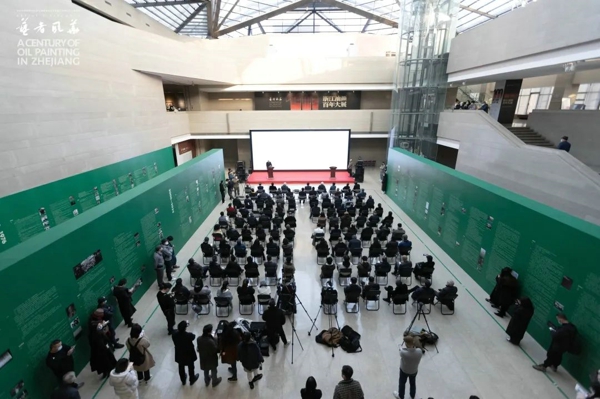
At the opening ceremony
Officials and guests who were present at the opening ceremony included: Lai Yingjie, executive deputy director of the Publicity Department of the CPC Zhejiang Provincial Committee; Xu Jiang, vice chairman of China Federation of Literary and Art Circles, president of China Oil Painting Society and chairman of Zhejiang Provincial Federation of Literary and Art Circles (ZPFLAC); Qian Xiaofang, vice director of the Education, Science, Culture and Health Committee of the Zhejiang Provincial CPC Committee; Yang Shouwei, secretary of the Party Group of the ZPFLAC; Diao Yuquan, deputy director and member of the Party Group of the Zhejiang Provincial Department of Culture and Tourism; Tong Yingjun, secretary of the Secretariat of the ZPFLAC;
University officials: Jin Yibin, secretary of the Party Committee of the CAA; Gao Shiming, president of the CAA and chairman of Zhejiang Artists Association; Fang Peixin, secretary of the Discipline Inspection Committee, Vice Presidents Shen Hao and Cao Xiaoyang, and Xu Guoqiang, member of the Party Committee and director of the Organization and United Front Department of the CAA; Yu Xuhong, secretary of the Secretariat of the ZPFLAC and director of the Propaganda Department of the CAA;
Representatives of the old artists: Quan Shanshi, Situ Li, Bai Renhai, Ye Qizhang, Zhou Ruiwen, Mo Dalin, etc.;
Senior officials of the ZPFLAC and the CAA: Song Jianming, Fu Suqin, Hu Zhonghua, Wang Zan, Meng Yunsheng, Luo Xianyue, etc.; as well as officials of the Publicity Department of the CPC Zhejiang Provincial Committee, Zhejiang Provincial Department of Culture and Tourism, the ZPFLAC and related support units and representative artists and media.
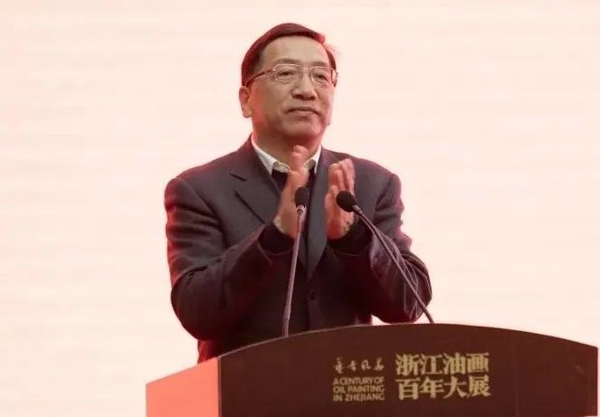
Lai Yingjie, executive deputy director of the Publicity Department of the CPC Zhejiang Provincial Committee announcing the opening of the exhibition

Xu Jiang, vice chairman of China Federation of Literary and Art Circles, vice chairman of China Artists Association, president of China Oil Painting Society and chairman of the ZPFLAC, delivering a speech
Xu Jiang said that in the exhibition Li Shutong is considered as the earliest sower of oil painting in the land of Zhejiang and prelude to the centenary history of oil painting in Zhejiang. This connection is made to, on one hand, show admiration for a generation of cultural pioneers and, on the other hand, emphasize the role of China’s New Culture Movement in catalyzing and nurturing South China and Zhejiang. In 1928, the National Academy of Art was established at the West Lake and the northern edge of Gushan Mountain in Hangzhou, gathering nationwide concerted efforts and support for the development of the art education and especially for the spread, implantation and popularity of Western oil painting in Hangzhou and Zhejiang. It set a fairly high level of poetic spirit at the start, which has been kept alive by generations of practitioners. For example, the painting practices and views of Mr. Quan Shanshi and Mr. Situ Li have profoundly influenced the painting and teaching of the CAA and have cultivated a group of important art creators. They represent the height of contemporary oil painting thinking in Zhejiang and China, have become important cultural phenomena in Zhejiang, and are always given attention and taken seriously in the painting and even academic circles at home and abroad.
For painters and artists, a humane mind, folk customs, and art principles are paramount. The first four parts of this exhibition, named “Centenary Epic”, “Supreme Heroism”, “Lofty Spirit”, and “Purity Pursuit”, are displayed at ZJAM. The fifth part “Romantic Breeze” is displayed in Zuikuiyuan Art Center at the same time.
The Chinese nation’s reverence for painting has a long history. “Painting” points to a creative and decisive mission and style that has a great impact. “Artistic Style” is a respect and tribute to the centenary oil painting in Zhejiang and this exhibition.
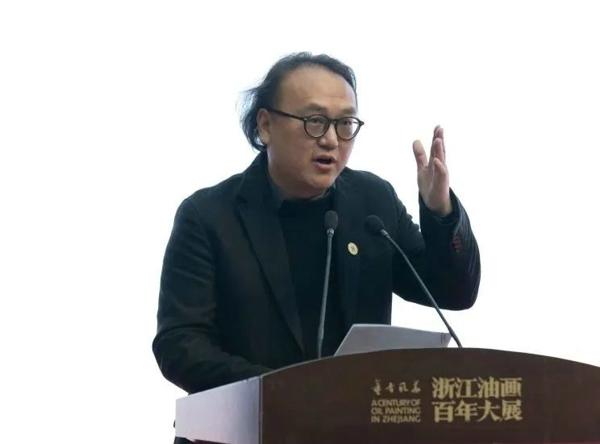
Gao Shiming, president of the CAA and chairman of Zhejiang Artists Association, delivering a speech
According to Gao Shiming, firstly, in the history of art in the twentieth century, the significance of the occurrence and development of oil painting in China was far more than the introduction of a painting genre. Generations of oil painters have plunged into the tide of history and created a number of magnificent works that bear historical narratives and crystallize the collective memory of the Chinese. We are proud to say that the oil painting in Zhejiang have effectively “shaped the image of the people, conveyed the spirit of the times, and depicted the landscape”.
Secondly, the birth of Chinese oil painting started the history of modern art education in China. The first generation of oil painters created the earliest art schools and laid a solid foundation for the modern art education in China. With two clear goals of realizing “harmony between the East and the West” and starting an “Art Movement”, oil painters like Lin Fengmian, Wu Dayu, and Fang Ganmin never gave up making efforts despite tremendous hardships in the twentieth century, and their achievements have survived to this day, as impressive in the new century and the new era as in their times.
Thirdly, in the history of Chinese oil painting, Zhejiang has always been a pivotal academic center. The oil painting in Zhejiang has made a firm cultural choice since day one to present the poetic sentiment and the freehand brushwork unique to the oriental culture. The second generation of artists, Zhao Wuji, Wu Guanzhong, and Zhu Dequn, created a new style of modern painting with the Chinese poetic sentiment and brushwork, which is unique in the history of modern art in the world. This is a gift that Zhejiang presents to the world. By reviewing the artistic achievements of the centenary oil painting in Zhejiang, we can perceive two innovative development schemes for Chinese oil painting - “imagery oil painting” and “nationalization of oil painting”. Both of these schemes represent the path of “Chinese modernization” that is a symphony of Chinese characteristics and people’s character and of present and history.
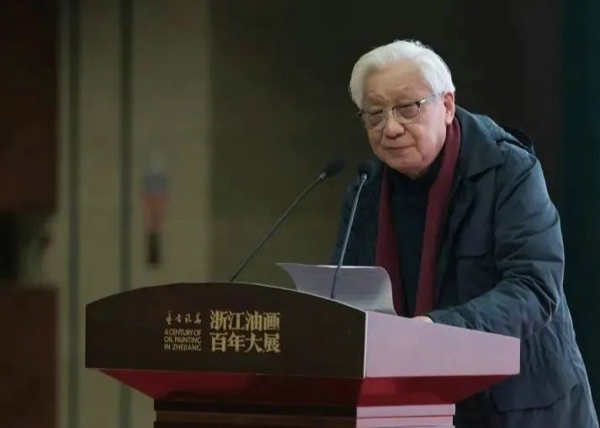
CAA Professor Quan Shanshi delivering a speech
Mr. Quan Shanshi said that the oil painting in Zhejiang has always had a high starting point and maintained a fairly high academic level. Several generations of painters have been exploring how to assimilate Western oil painting and how to make oil painting better serve the people and socialism. They have made unremitting efforts to inject Chinese characteristics into oil painting. As a generation of oil painters who have been cultivated since the founding of New China, we, on the one hand, benefit from the mission entrusted by history. On the one hand, our generation is “congenitally deficient” due to historical limitations and barely makes a difference or makes contributions in the oil painting field. We can only serve as paving stones. However, things are very different today! Mr. Quan hoped that young people today will carry forward the experience of their predecessors, maintain integrity and make innovation, and “move from plateau to peak”.
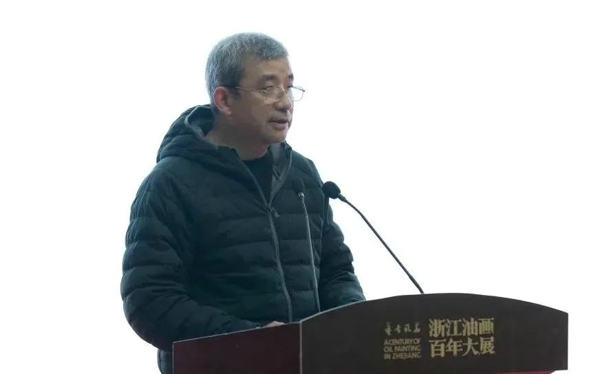
He Hongzhou, dean of the School of Painting Art of the CAA, delivering a speech
He Hongzhou, dean of the School of Painting Art of the CAA, said that he can deeply feel the development of oil painting in Zhejiang based on his own experience and the words and deeds of his teachers. He noted two development types of oil painting in Zhejiang: One is the paintings with expressionist characteristics and the spirit of Chinese literati in the early days of the CAA, and the other is the realistic oil painting tradition with the realist spirit that has been formed after the founding of New China. These two types of painting intertwine from time to time and contribute together to the charm of oil painting in Zhejiang. The language of oil painting is very appealing, and the rich and vivid expression of oil painting in terms of shape, color and light is often compared to symphony; the language of oil painting excels in creating a “grand narrative” of history and thematic painting, and because of the difficulty and huge workload, oil painting is compared to “heavy industry” among different painting genres. The missionary spirit of artists runs through different historical periods of oil painting in Zhejiang, and it has been deeply seated in the land of Zhejiang like a tree in a history of a hundred years, with a deep root and flourishing branches. As an artist participating in this exhibition, I would like to thank the great era in which I live and the land of Zhejiang and its humanistic sentiment for providing a space for oil painting to grow! I appreciate our predecessors for their hard work to help oil painting take root in Zhejiang! There is reason to believe that oil painting has great potential to tell the story of China and show the creativity of artists!
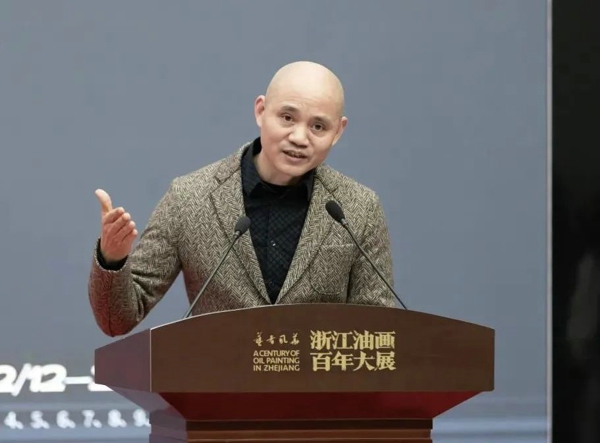
The opening ceremony moderated by Ying Jinfei, curator of ZJAM
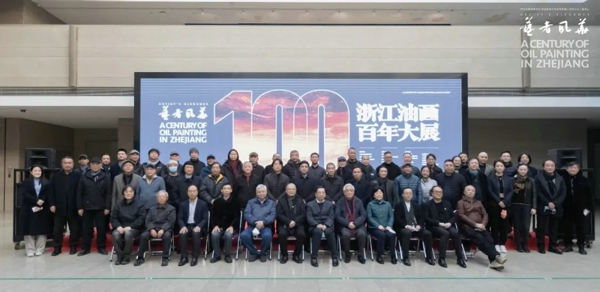
A group photo of the guests
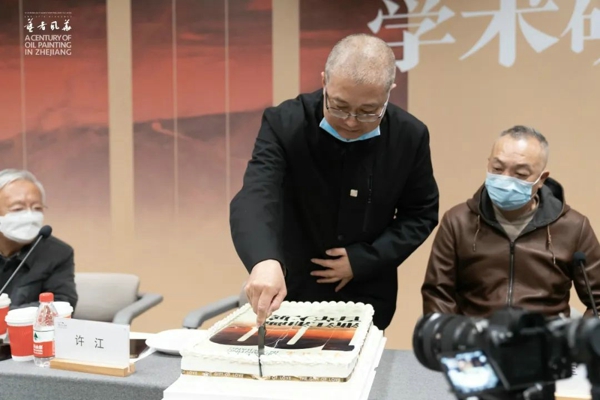
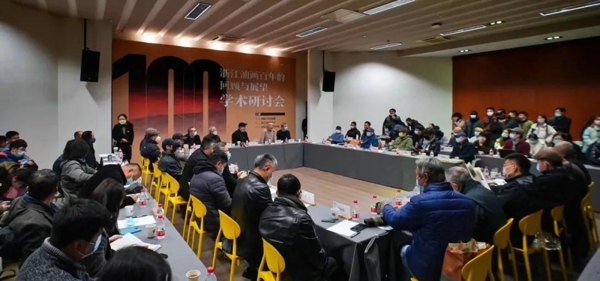
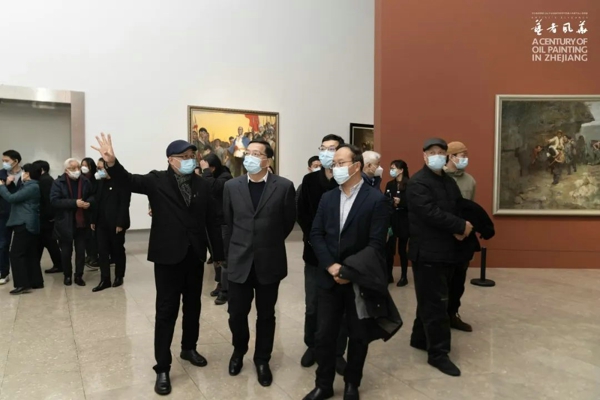
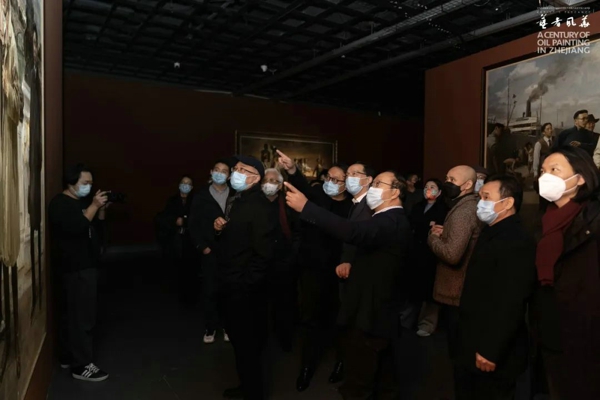
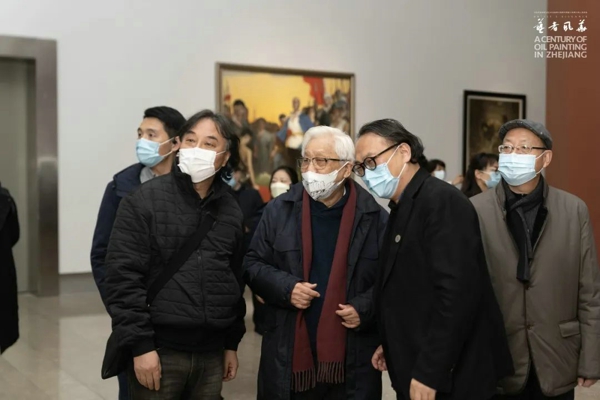
A photo taken at the venue of the opening ceremony
 Tel: 0571-87078700 | Site Service:0571-87078700
Tel: 0571-87078700 | Site Service:0571-87078700 Address: NO.138 Nanshan Road Hangzhou Zhejiang
Address: NO.138 Nanshan Road Hangzhou Zhejiang Opening: Tuesday to Sunday 9:00am-5:00pm, Closed Mondays
Opening: Tuesday to Sunday 9:00am-5:00pm, Closed Mondays


















